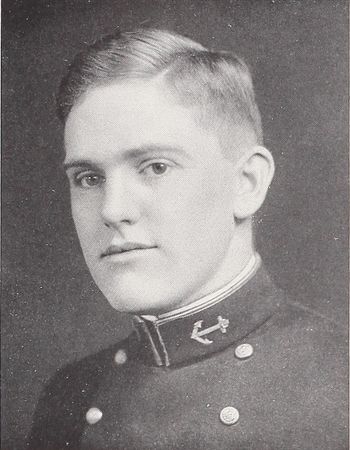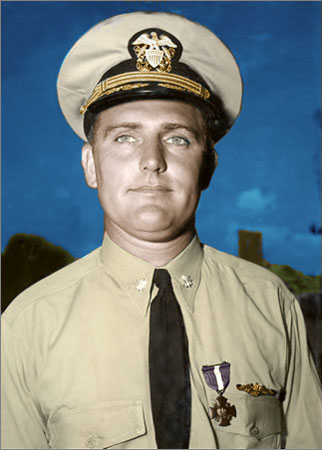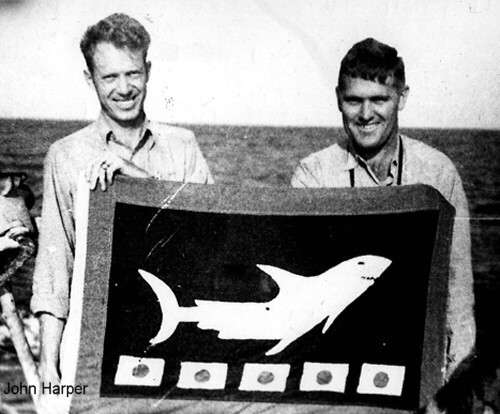EDWARD N. BLAKELY, CDR, USN
Edward Blakely '34
Lucky Bag
From the 1934 Lucky Bag:
EDWARD NOE BLAKELY
Norristown, Pennsylvania
"Eddie" "Enoe" "Blake"
THIS specimen of manhood hails from the world's largest borough — Norristown, Pennsylvania. What! never heard of it? Ask him its chief industry. Eddie has the regular faults as far as toothpaste, shirts, socks, etc. are concerned; but (thank Heavens) he does not take his wife's scags! However he can be relied up every Thursday morning to borrow the last pair of skivvies.
This man has a certain little way all of his own of getting along — Blondes, Brunnettes, Rebels, and Yankees. But Blake has stronger stuff in him. Yes indeed, he isn't afraid to turn in before a term exam. He gets along alright with the Ac Departments and goes slumming in the anchor section or rubs noses with the intelligencia. Variety is the spice of life, says he.
He saunters out with those pet disci of his occasionally and flings them at two stripers. Sometimes he gets up at midnight to practice form and it immediately recalls the home town industry. He has a few other passions too. Ask him how many windows he broke Youngster Year, and if he says ten he is just being modest.
But when all's said and done, you can't get another wife like him. That cheery disposition, even in the teeth of a Monday Morning, is something to talk about. Yes sir, he is a good wife and just a little ray of sunshine. Three cheers from the common people for Blake!
Plebe Football. Track. Varsity Track 3, 2, 1. Pep Committee. Reception Committee. 2 P.O.

EDWARD NOE BLAKELY
Norristown, Pennsylvania
"Eddie" "Enoe" "Blake"
THIS specimen of manhood hails from the world's largest borough — Norristown, Pennsylvania. What! never heard of it? Ask him its chief industry. Eddie has the regular faults as far as toothpaste, shirts, socks, etc. are concerned; but (thank Heavens) he does not take his wife's scags! However he can be relied up every Thursday morning to borrow the last pair of skivvies.
This man has a certain little way all of his own of getting along — Blondes, Brunnettes, Rebels, and Yankees. But Blake has stronger stuff in him. Yes indeed, he isn't afraid to turn in before a term exam. He gets along alright with the Ac Departments and goes slumming in the anchor section or rubs noses with the intelligencia. Variety is the spice of life, says he.
He saunters out with those pet disci of his occasionally and flings them at two stripers. Sometimes he gets up at midnight to practice form and it immediately recalls the home town industry. He has a few other passions too. Ask him how many windows he broke Youngster Year, and if he says ten he is just being modest.
But when all's said and done, you can't get another wife like him. That cheery disposition, even in the teeth of a Monday Morning, is something to talk about. Yes sir, he is a good wife and just a little ray of sunshine. Three cheers from the common people for Blake!
Plebe Football. Track. Varsity Track 3, 2, 1. Pep Committee. Reception Committee. 2 P.O.
Loss
Ed was lost when USS Shark (SS 314) was sunk by the Japanese destroyer Harukaze off Taiwan on October 24, 1944. He was the boat's Commanding Officer.
Other Information
From researcher Kathy Franz:
Edward was christened on October 12, 1912, at Elkins Park, Cheltenham Township, Montgomery County, Pennsylvania.
In 1935, he lived in San Diego. He married Virginia Sampson on August 28, 1936, in Los Angeles. In 1940, he and his wife lived in Vallejo Township in California, and his address in 1944 was Brentwood, West Los Angeles.
Edward received command of the Shark when it was commissioned in February, 1944.
He was survived by his wife, his 2-year-old son Edward, Jr., and his mother.
In 1920, his father Dillwyn was secretary and treasurer of a pattern company. His mother and older sister were both named Florence. His father died in 1927. In 1930, his brother Richard was age 2 years and 8 months.
His wife was listed as next of kin. He is included at the Manila American Cemetery and Memorial.
Remembrances
From "The Voices of Bombing Nineteen":
Our first sign that we were about to be picked up came when some fighters started buzzing us. They dropped a couple of smoke lights to mark us, and we threw dye marker around like mad, me getting most of it on myself. The sub finally came into view, and what a beautiful sight it was! Harvey and I almost fell overboard trying to wave at it. After a little trouble we got aboard OK, and what a comfortable feeling that is!
So help me, these sub boys are the tops. Nothing is too good for you when you come aboard under our circumstances. We got a hot shower, clean dry clothes, cigarettes, coffee, hot soup, etc. All we had to do was name it, and we could have it. After being introduced all around and trying to put something in my stomach (which wouldn't stay), I hit the sack. Harvey did the same aft in the men's quarters. When I woke up it was time for chow, so I tried it again, and it stayed down this time. By the way, their food is the tops. After having a little more bull session, the topics being planes and subs, I hit the sack for good that night, winding up what I would call a "rather full day".
5 August 1944 - I wandered around the ship wondering what all the gadgets were. I got the word on the general run of the ship from one of the officers who took me on a sightseeing tour. We had to make several dives that day and night, just because some "fly-fly boy" (the sub boys' pet name for us) forgot his "trigger". We were still playing lifeguard and went hunting for one of our planes that was forced down - no luck, though.
The chow on these boats amazed me more every time we ate. I was up on the bridge for a few minutes and later had my first look through a periscope. We had to make a couple of fast dives that night - bogies, I guess. I hit the sack about 10 PM to wind up my first full day aboard one of Uncle Sam's subs on patrol.
6 August 1944 - I woke up about 0700, just in time to have breakfast with the Skipper, who, by the way, is one hell of a swell guy. After that I went up in the conning tower to see what was going on. They let me take the helm for about a half hour, but that's enough said about that, because the wake, after I got through, looked like the trail of a snake with a broken back. I then had a long look through the periscope at "my island". For some reason, it still looked rather innocent. My thoughts about its innocence had another rough jolt when right in the middle of lunch a couple of Hamps or Zeros slipped up close on us before we saw them. Our lookouts saw them in time, however, for us to get pretty well below the surface with a fast dive before they could drop their depth charges. They dropped them just the same, though. Three of them went off - WHAM! (pause) WHAM! WHAM! It happened so fast it was over before I realized what had happened. There was no damage, however, and it didn't seem to impress anybody very much. I don't mean that these guys like to get dropped on, but I guess one can get accustomed to most anything. Not five minutes after this happened, somebody suggested a poker game, so I joined all the officers who were not on duty and got wound up in the pasteboards. I proceeded, as per my usual game, to lose $6.50. This broke up before chow, so this gave me time to wash up and shave (?) I shaved for my first beard that day. It was only a few days gone, but it promised to look pretty sharp in about a month.
Back to this subject of chow - that word "chow" is a masterpiece of understatement. It's like eating at your favorite restaurant every meal.
That night we had roast chicken, mashed potatoes, carrots and peas, gravy, olives, coffee, and, last but not least, the best ice cream I'd had since I left the states. Pineapple was the flavor, and was it good! After dinner we went to "darken ship". That means that all white lights are turned out and there is nothing but red ones on. This is done so they won't be blind when they go up on the bridge for their watch.
I've noticed a few little things. First, the uniform - it's great - shorts and a "T" shirt. That's it for everybody, from the Skipper to the lowest rated man in the crew. Second, sleeping - there doesn't seem to be any regular hours for it. Everybody seems to sleep when there isn't anything else to do or when they are not on watch.
7 August 1944 - I woke up about 0700 to start a very quiet day. It was getting so that I woke up automatically at this time every morning, just in time for breakfast. I sort of had to get up, though, because my sack was just about one-half of all the seats in the wardroom. After breakfast the Skipper and I played a game of Gin Rummy. I managed to win from him, too. I had a very close look at one of the Japs' "unsinkable" aircraft carriers through the periscope. If there had been any Jap wahinies on the beach we would have been able to see them. We sure as hell were close enough. This was the first day since I had been aboard that they hadn't been looking for some more "zooms" like me to fish aboard. We were strictly on the hunt that day. After noon chow (which was good as usual), I hit the sack for a couple of hours since there was nothing much else to do. We submerged about 0230, and at about 1900 we surfaced. At 2230 I was up on the bridge. I noted: "There is almost a full moon and the sky is as clear as a bell. Our course right this minute is right up the moon path. There's a slight breeze which makes it just about perfect. (Perfect is right, just about right for one of those little bastards to slip up on us.) I think the general opinion is that it's a hell of a night to fight a war. It's about time I hit the hay for a little shuteye."
8 August 1944 - One of the Japs' fly-boys pulled a very dirty and unethical trick. It was strictly not according to Hoyle. The Japs, being very cagey and observing, noticed that when one of our flyers is floating in his little rubber boat in this big ocean at night, he proceeds to let anybody know where he is by shooting a certain color flare. Well, the slant-eyes figured this was a good chance to get a shot at one of our subs or anybody who came around hoping he can do his good deed for the day by dragging some poor devil out of the drink. So they dropped a few flares from a plane every now and then and then moved off a little way and waited developments. This is just what happened. Naturally, when our lookouts spotted the flare, we started towards it, knowing full well it could be a trick, but that didn't seem to bother these sub-boys. I guess they figured there just as well could be somebody out there, and they were going to find out if there was - and if not, who in hell was yelling "wolf"? Well, a Jap plane jumped us, but we dove away from him with no trouble, except that the diving horn woke me up. "Tsk, tsk - no manners, these Japs". The Skipper also has his own name for them. To quote, "(censored)", unquote!
NOTE: The above was written aboard the USS Shark. After spending a month aboard, plus a wonderful two weeks leave with the crew of the U.S.S. Shark at the Royal Hawaiian Hotel, arranged by the Skipper, I never saw them again. The U.S.S. Shark II (SS-314) was reported overdue and presumed lost with all hands as of 24 October 1944. Bill Emerson
Photographs
Edward, right, following Shark's first war patrol. With John Harper, Jr. '39.
Career
From the now-broken link http://www.fleetorganization.com/subcommandersclassyear3.html:
- Navigator USS S-28 (SS-133) 1 Jul 1939 - 1 Nov 1940
- Executive Officer USS Tuna (SS-203) 1 Jan 1942 - 1 Apr 1943
- Captain USS Shark (SS-314) 14 Feb 1944 - Oct 1944
- Lieutenant (j.g.) 31 May 1937
- Lieutenant 1 Jul 1941
- Lieutenant Commander (T) 1 Mar 1943
- Commander (T) 1 Feb 1944
From Hall of Valor:
The President of the United States of America takes pride in presenting the Navy Cross (Posthumously) to Commander Edward Noe Blakely (NSN: 0-73372), United States Navy, for extraordinary heroism in the line of his profession as Commanding Officer of the U.S.S. SHARK (SS-314), on the FIRST War Patrol of that submarine, during the period 16 May 1944 to 17 June 1944, in enemy controlled waters west of the Mariana Islands, his first as Commanding Officer. With daring and aggressive determination in the face of unusually strong and alert enemy escorts, which included both air and surface craft, Commander Blakely skillfully executed three well-planned and brilliantly executed torpedo attacks which resulted in the sinking of our enemy ships for a total of 32,200 tons and damaging of one 5,600 ton freighter. Skillful evasive action enabled him to escape enemy counter-measures and avoid damage to his ship. Through his experience and sound judgment Commander Blakely brought his ship safely back to port. His conduct throughout was an inspiration to his officers and men and in keeping with the highest traditions of the United States Naval Service.
General Orders: Commander In Chief Pacific Fleet: Serial 04780 (September 11, 1944)
Action Date: May 16 - June 17, 1944
Service: Navy
Rank: Commander
Company: Commanding Officer
Division: U.S.S. Shark (SS-314)
Silver Star
From Hall of Valor:
The President of the United States of America takes pride in presenting the Silver Star (Posthumously) to Lieutenant Commander Edward Noe Blakely (NSN: 0-73372), United States Navy, for conspicuous gallantry and intrepidity in action while serving aboard the U.S.S. TUNA (SS-203), during the FIRST War Patrol of that Submarine in enemy controlled waters from 26 January to 21 March 1942. As an Officer of the Ship's Company he repeatedly gave great aid to the Commanding Officer of the vessel in conducting a commendable patrol under adverse weather conditions and against strong air and surface anti-submarine craft. His calm inspiring demeanor to those serving under him, and his outstanding physical endurance and untiring effort during time of attack and counterattack were of incalculable help in maintaining the crew and vessel in a state of maximum efficiency. His actions were in keeping with the highest traditions of the United States Naval Service.
General Orders: Commander 7th Fleet: Serial 02010 (July 26, 1944)
Action Date: January 26 - March 21, 1942
Service: Navy
Rank: Lieutenant Commander
Division: U.S.S. Tuna (SS-203)
The "Register of Commissioned and Warrant Officers of the United States Navy and Marine Corps" was published annually from 1815 through at least the 1970s; it provided rank, command or station, and occasionally billet until the beginning of World War II when command/station was no longer included. Scanned copies were reviewed and data entered from the mid-1840s through 1922, when more-frequent Navy Directories were available.
The Navy Directory was a publication that provided information on the command, billet, and rank of every active and retired naval officer. Single editions have been found online from January 1915 and March 1918, and then from three to six editions per year from 1923 through 1940; the final edition is from April 1941.
The entries in both series of documents are sometimes cryptic and confusing. They are often inconsistent, even within an edition, with the name of commands; this is especially true for aviation squadrons in the 1920s and early 1930s.
Alumni listed at the same command may or may not have had significant interactions; they could have shared a stateroom or workspace, stood many hours of watch together, or, especially at the larger commands, they might not have known each other at all. The information provides the opportunity to draw connections that are otherwise invisible, though, and gives a fuller view of the professional experiences of these alumni in Memorial Hall.
July 1934
October 1934
January 1935
April 1935
October 1935
January 1936
April 1936
July 1936
ENS Martin Ray, Jr. '34 (USS Pennsylvania)
ENS Jack Ferguson '35 (USS Pennsylvania)
ENS George Lambert '35 (USS Pennsylvania)
ENS Hubert Harden '35 (USS Pennsylvania)
January 1937
ENS Martin Ray, Jr. '34 (USS Pennsylvania)
ENS Jack Ferguson '35 (USS Pennsylvania)
ENS George Lambert '35 (USS Pennsylvania)
ENS Hubert Harden '35 (USS Pennsylvania)
April 1937
ENS Martin Ray, Jr. '34 (USS Pennsylvania)
ENS Jack Ferguson '35 (USS Pennsylvania)
September 1937
July 1938
January 1939
October 1939
June 1940
November 1940
April 1941

The "category" links below lead to lists of related Honorees; use them to explore further the service and sacrifice of alumni in Memorial Hall.

